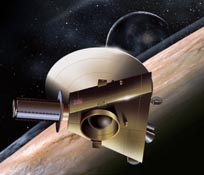
With luck and another $260 million in funding, the New Horizons spacecraft will be skimming past distant, enigmatic Pluto (foreground) and its moon, Charon, 15 years from now. Selected by NASA last December, the spacecraft features four instruments, a plutonium-fueled powerplant, and a radio dish 2.5 meters (8 feet) across.
Courtesy JHU/Applied Physics Laboratory and Dan Durda.
After a year-long study, a National Research Council panel has concluded that sending a spacecraft to several bodies in the Kuiper Belt, including Pluto, should be NASA's highest solar-system priority in the coming decade. The NRC study, conducted by 60 top U.S. planetary scientists and released today, also endorses a Europa Geophysical Explorer (EGE) mission to place a craft in orbit around Jupiter's enigmatic icy moon Europa, as well as several other missions. But the survey committee made it clear that the Kuiper-Pluto mission's technical feasibility and lower cost give it "clear advantages over EGE."
The study's recommendations, kept confidential until today, come as a welcome surprise to the team working on the New Horizons mission, which could be launched as early as 2006 and reach Pluto and Charon (its moon) by 2016. "This is great news," says S. Alan Stern, the mission's principal investigator. "I've lost a lot of sleep this past week." Edward J. Weiler, NASA's associate administrator for space science, has stated that the space agency could not commit to a Pluto-Kuiper effort unless the planetary-science community backed it. The Bush administration excluded New Horizons from NASA's fiscal 2002 budget, but Congress later authorized $30 million to begin its development. Nor was it included in the president's fiscal 2003 budget, though Congress may opt to fund the mission anyway.
"Given the scientific value and the unique timing, we would be missing an historic opportunity if we don’t move forward with this project and make this mission a reality," comments Sen. Barbara A. Mikulski (Maryland), who chairs the Senate appropriations subcommittee responsible for NASA. "I intend to restore funding again this year, despite NASA’s failure to include money for Pluto in the FY03 budget."
Titled New Frontiers in the Solar System: An Integrated Exploration Strategy, the massive NRC study was initiated by Weiler in early 2001 in order to create community-wide consensus concerning key solar-system objectives and mission candidates. "To continue [solar-system] exploration in the most productive way," notes study chairman Michael J. S. Belton, NASA's missions must be prioritized." Belton and his 14-member steering committee modeled their effort after similar roadmaps that have been developed by the astrophysics community, the most recent of these having appeared last year.
Initially the NRC survey was to assess four broad topics: inner planets, giant planets, large satellites, and primitive bodies. However, when it became clear that other high-level groups were already engaged in assessing the prospects for Mars and astrobiology, these groups' expertise was added to the New Frontiers effort. A key component was input provided by nearly 400 planetary scientists through an extensive series of position papers, which are being published separately. "While there have been many previous NRC studies over the decades," notes Belton, "this is the first to involve the community as a whole."
In the end, the survey committee recommended a suite of missions for the period 2003–2013. These are grouped into three cost categories: "small" missions will cost less than $325 million; "New Frontiers," a mission category introduced in NASA's budget this year, will total less than $650 million and might be flown every three years; and "Flagship" missions, high-cost, once-per-decade undertakings that are well suited to international participation.
More information on Pluto can be found at the Pluto Portal.
| SOLAR-SYSTEM FLIGHT RECOMMENDATIONS (excluding Mars) | ||
| Priority | Mission | Description |
| Small missions (<$325 million) | ||
| 1 | Discovery missions | Small, innovative missions led by a single principal investigator |
| 2 | Cassini Expanded | An extension of the Cassini orbiter's mission at Saturn |
| "New Frontiers" missions (<$650 million) | ||
| 1 | Kuiper Belt-Pluto Explorer | A flyby mission of several Kuiper Belt objects, including Pluto/Charon, to discover their physical nature and understand their endowment of volatiles |
| 2 | South Pole-Aitken Basin Sample Return | A mission to return samples from the solar system's deepest crater, which pierces the Moon's mantle |
| 3 | Jupiter Polar Orbiter with Probes | A close-orbiting polar spacecraft equipped with various instruments and a relay for three probes that make measurements below the 100-bar level |
| 4 | Venus In-situ Explorer | A cored sample of Venus to be lifted into the atmosphere for compositional analysis; simultaneous atmospheric measurements |
| 5 | Comet Surface Sample Return | Several pieces of a comet's surface to be returned to Earth for organic analysis |
| "Flagship" missions (>$650 million) | ||
| 1 | Europa Geophysical Explorer | An orbiter of Jupiter's ice-encrusted satellite to seek the nature and depth of its ocean |
| MARS FLIGHT RECOMMENDATIONS (beyond 2005) | ||
| Priority | Mission | Description |
| Small missions (<$325 million) | ||
| 1 | Mars Scout line | A competitively selected series of Mars missions similar in concept to Discovery |
| 2 | Mars Upper-Atmosphere Explorer | A spacecraft dedicated to studies of Mars's upper atmosphere and plasma environment |
| Medium missions (<$650 million) | ||
| 1 | Mars Smart Lander | A lander to carry out sophisticated surface observations and to validate sample-return technologies |
| 2 | Mars Long-lived Lander Network | A globally distributed suite of landers equipped to make comprehensive measurements of the planet's interior, surface, and atmosphere |
| "Flagship" missions (>$650 million) | ||
| 1 | Mars Sample Return | A program to return several samples of the Red Planet and to search for life, develop chronology, and define ground truth |
 0
0
Comments
You must be logged in to post a comment.